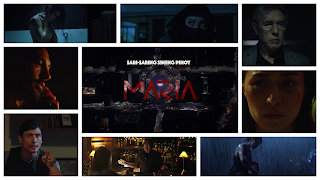Maria (Blackops Studios Asia, Viva Films, 2019) paints its setting in broad strokes. The film’s action takes place in a generic space occupied by stilted characters. Two assassins, Kaleb (Ivan Padilla) and Victor (KC Montero) trade wince-inducing banter while waiting for new assignments from their father, Ricardo de la Vega (Freddie Webb), head of the BlackRose cartel. Interacting with them all is Lily/Maria (Christine Reyes), a woman who’s introduced via a series of images that reduce her to flashing brown eyes and pursing lips. In fact, Erik Matti’s Buy Bust (2018) stands out as the closest analog to this film, yet the comparison to Matti’s freewheeling, deconstructionist take does this lugubrious thriller no favors, as director Pedring A. Lopez doesn’t so much as dust off the cobwebs from the tropes he recycles throughout. Maria’s actors are awkward and stiff in trying to project hard-boiled cool and all while delivering lines that sound as if they had been passed multiple times through an online translation tool. Even Reyes, a master of the cat-who-ate-the-canary grin is unable to fill the gaps left by the film’s unambitious screenplay. With the exception of her initial interactions with Kaleb, Lily/Maria offers nothing deeper than perfunctory poses. Chasing after a quick and painless death, Kaleb picks up on her true nature and discusses the possibility of expediting her demise. As Kaleb mull the pros and cons of his plan, the film suddenly feels uniquely sardonic and almost poignant. But then another hollow twist kills the mood, reducing even this exchange to more grist for the mill of Lopez’s lifeless genre gamesmanship.
Maria was shot digitally by cinematographer Pao Orendain. The frame is routinely awash in brightly fluorescent blues, reds, greens, oranges and yellows with different hues often competing for attention. Alternating shadows and streaks of bright light scream while there's barely a natural flesh tone in sight. Fine detail is superior where it's intended to be visible (mostly in closeups) but routinely fades into darkness or is blown out by intense brightness. However, the image is not without flaws. Occasional banding appears, but it's minor and brief. More serious is the subtle but frequent background noise in the riotous clashes of colors and these recur in irregular background streaks throughout the film. They will be more or less obvious depending on the size of your display and its settings,and they are fleeting enough to pass without major distraction. Maria's 5.1 soundtrack is loud and you may find it necessary to turn down your customary volume setting by a few db. It's not the sound effects which are effective though relatively modest, but the score by Jessie Lasaten has been mixed to fill the entire speaker array, pulsing and throbbing as it does its best to rise to the level of the overcooked visuals. To the sound mixers' credit, the dialogue never gets buried, remaining intelligible and firmly anchored to the front but, like the bright colors and odd angles onscreen, the soundtrack is working overtime to knock you sideways with suspense and foreboding in a film where nothing much happens and the ultimate reveals aren't worth the wait. Lopez shows promise as a visual stylist, but he needs a gifted screenwriter. Maria is a potentially interesting experiment betrayed by the weaknesses of a derivative script. If you're curious, stream it, given the unfortunate overcompression.
Directed By: Pedring Lopez
Written By: YC Carbonell, Rex Lopez
Music By: Jessie Lasaten
Director of Photography: Pao Orendain
Edited By: Jason Cahapay
Production Design: Raymund 'Diong' Fernandez
Sound: Albert Michael M. Idioma






